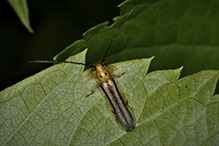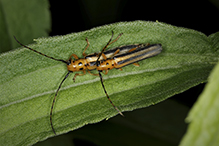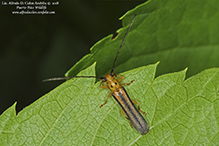Dogwood twig borer
(Oberea tripunctata)
Conservation • Description • Habitat • Ecology • Distribution • Taxonomy
|
|
||||||||||||||
Description |
Dogwood twig borer is a small, flat-faced, long-horned beetle. The body is long, slender, and cylindrical. Mature adults are 5 ⁄16″ to ⅝″ and less than ⅛″ wide. The upper thoracic shield (pronotum) is cylindrical, wider than long, yellowish-tan, and smooth. The upper (dorsal) surface is convex with a black bump on each side and a black spot at the rear (posterior) margin. The hardened wing covers (elytra) are yellowish-tan, pitted, slender, and slightly narrowed in the middle. On each elytron there is a broad black stripe on the outer (lateral) margin and a narrow stripe on the inner (sutural) margin that pairs with the one on the opposite elyturm to make a broad central stripe. The small plate between the bases of the elytra (scutellum) is black. The head is yellowish-tan. The face is nearly flat. The eyes are black and deeply notched. The bases of the antennae are inserted into the notch. The antennae are as slightly shorter to slightly longer than the body. The antennal segments are yellowish-tan at the base and black at the tip. The amount of black is variable, and occasionally the segments appear entirely black. The first segment is always entirely black. The outer margin of the mandible is nearly straight. The end segment of the finger-like process (palp) on the maxilla is pointed. The legs are entirely yellowish-tan. The last part of each leg (tarsus), corresponding to the foot, has five segments but the fourth segment is minute, making it appear that there are only four segments. |
Size |
Total length: 5 ⁄16″ to ⅝″ |
Similar Species |
Habitat |
|
Ecology |
Season |
Late May to early August (Michigan) |
Behavior |
|
Life Cycle |
The female creates a pair of slits in a twig and deposits a single egg. When the egg hatches, the larva bores into the twig to the center. The larva overwinters inside the twig. |
Larva Food |
Twigs and branches of mostly dogwood but also elm, viburnum, blueberry, Labrador tea, poplar, willow, and mulberry. |
Adult Food |
Leaves of mostly dogwood but also elm, viburnum, blueberry, Labrador tea, poplar, willow, and mulberry. |
Distribution |
||
|
Sources |
|
| 8/19/2025 | ||
Occurrence |
||
Widespread |
||
Taxonomy |
|
Order |
Coleoptera (Beetles) |
Suborder |
Polyphaga (Water, Rove, Scarab, Long-horned, Leaf, and Snout Beetles) |
Infraorder |
Cucujiformia |
Superfamily |
Chrysomeloidea (longhorn and leaf beetles) |
Family |
Cerambycidae (longhorn beetles) |
Subfamily |
Lamiinae (flat-faced longhorn beetles) |
Tribe |
Saperdini |
Genus |
Oberea |
|
|
Superfamily |
|
Subordinate Taxa |
|
|
|
Synonyms |
|
Cerambyx tripunctatus Oberea amabilis Oberea appalachiana Oberea bimaculata var. tripunctata Oberea mandarina Oberea tripunctata appalachia Oberea tripunctata appalachiana Oberea tripunctata intermedia Oberea tripunctata intermedia Oberea tripunctata mandarina Oberea tripunctata var. amabilis Oberea tripunctata var. appalachiana Oberea tripunctata var. intermedia Oberea tripunctata var. mandarina Oberea tripunctata var. subdeficiens Oberea tripunctata var. subexilis Oberea tripunctata var. tripunctata Saperda mandarina Saperda tripunctata |
|
Common Names |
|
dogwood twig borer |
|
Glossary
Elytra
The hardened or leathery forewings of beetles used to protect the fragile hindwings, which are used for flying. Singular: elytron.
Pronotum
The exoskeletal plate on the upper side of the first segment of the thorax of an insect.
Scutellum
The exoskeletal plate covering the rearward (posterior) part of the middle segment of the thorax in some insects. In Coleoptera, Hemiptera, and Homoptera, the dorsal, often triangular plate behind the pronotum and between the bases of the front wings. In Diptera, the exoskeletal plate between the abdomen and the thorax.
Tarsus
The last two to five subdivisions of an insect’s leg, attached to the tibia; the foot. Plural: tarsi.
Visitor Photos |
||
Share your photo of this insect. |
||
This button not working for you? |
||
Alfredo Colon |
||
 |
 |
|
 |
||
MinnesotaSeasons.com Photos |
||
|
||
|
||

Slideshows |
|

Visitor Videos |
||
Share your video of this insect. |
||
This button not working for you? |
||
|
Other Videos |
||
|

Created: 10/12/2018 Last Updated: © MinnesotaSeasons.com. All rights reserved. |



